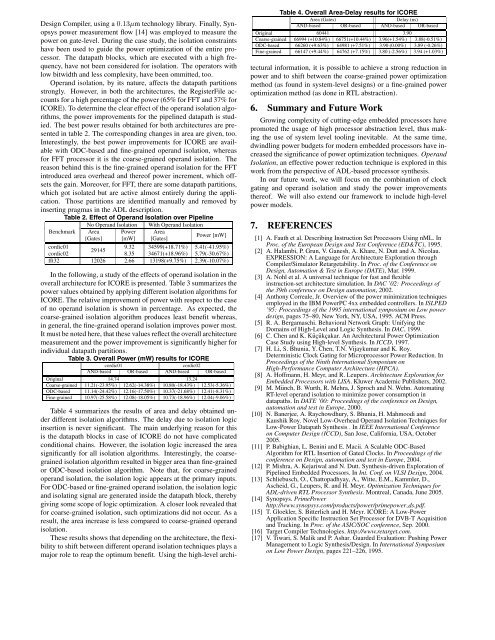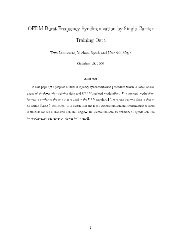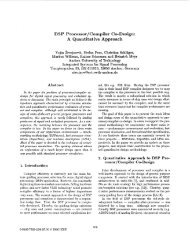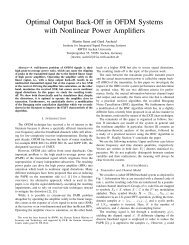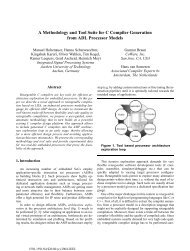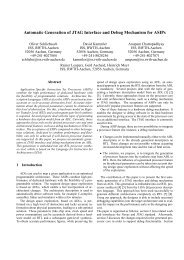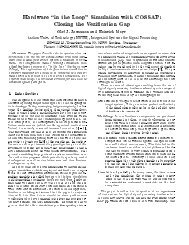Automatic ADL-based Operand Isolation for Embedded Processors
Automatic ADL-based Operand Isolation for Embedded Processors
Automatic ADL-based Operand Isolation for Embedded Processors
You also want an ePaper? Increase the reach of your titles
YUMPU automatically turns print PDFs into web optimized ePapers that Google loves.
Design Compiler, using a 0.13µm technology library. Finally, Synopsys<br />
power measurement flow [14] was employed to measure the<br />
power on gate-level. During the case study, the isolation constraints<br />
have been used to guide the power optimization of the entire processor.<br />
The datapath blocks, which are executed with a high frequency,<br />
have not been considered <strong>for</strong> isolation. The operators with<br />
low bitwidth and less complexity, have been ommitted, too.<br />
<strong>Operand</strong> isolation, by its nature, affects the datapath partitions<br />
strongly. However, in both the architectures, the RegisterFile accounts<br />
<strong>for</strong> a high percentage of the power (65% <strong>for</strong> FFT and 37% <strong>for</strong><br />
ICORE). To determine the clear effect of the operand isolation algorithms,<br />
the power improvements <strong>for</strong> the pipelined datapath is studied.<br />
The best power results obtained <strong>for</strong> both architectures are presented<br />
in table 2. The corresponding changes in area are given, too.<br />
Interestingly, the best power improvements <strong>for</strong> ICORE are available<br />
with ODC-<strong>based</strong> and fine-grained operand isolation, whereas<br />
<strong>for</strong> FFT processor it is the coarse-grained operand isolation. The<br />
reason behind this is the fine-grained operand isolation <strong>for</strong> the FFT<br />
introduced area overhead and thereof power increment, which offsets<br />
the gain. Moreover, <strong>for</strong> FFT, there are some datapath partitions,<br />
which got isolated but are active almost entirely during the application.<br />
Those partitions are identified manually and removed by<br />
inserting pragmas in the <strong>ADL</strong> description.<br />
Table 2. Effect of <strong>Operand</strong> <strong>Isolation</strong> over Pipeline<br />
No <strong>Operand</strong> <strong>Isolation</strong> With <strong>Operand</strong> <strong>Isolation</strong><br />
Benchmark Area Power Area<br />
Power [mW]<br />
[Gates] [mW] [Gates]<br />
cordic01<br />
9.32 34599(+18.71%) 5.41(-41.95%)<br />
29145<br />
cordic02 8.35 34671(+18.96%) 5.79(-30.67%)<br />
fft32 12026 2.66 13198(+9.75%) 2.39(-10.07%)<br />
In the following, a study of the effects of operand isolation in the<br />
overall architecture <strong>for</strong> ICORE is presented. Table 3 summarizes the<br />
power values obtained by applying different isolation algorithms <strong>for</strong><br />
ICORE. The relative improvement of power with respect to the case<br />
of no operand isolation is shown in percentage. As expected, the<br />
coarse-grained isolation algorithm produces least benefit whereas,<br />
in general, the fine-grained operand isolation improves power most.<br />
It must be noted here, that these values reflect the overall architecture<br />
measurement and the power improvement is significantly higher <strong>for</strong><br />
individual datapath partitions.<br />
Table 3. Overall Power (mW) results <strong>for</strong> ICORE<br />
cordic01<br />
cordic02<br />
AND-<strong>based</strong> OR-<strong>based</strong> AND-<strong>based</strong> OR-<strong>based</strong><br />
Original 14.74 13.24<br />
Coarse-grained 11.21(-23.95%) 12.62(-14.38%) 10.80(-18.43%) 12.53(-5.36%)<br />
ODC-<strong>based</strong> 11.14(-24.42%) 12.16(-17.50%) 10.37(-21.68%) 12.41(-8.31%)<br />
Fine-grained 10.97(-25.58%) 12.08(-18.05%) 10.73(-18.96%) 12.04(-9.06%)<br />
Table 4 summarizes the results of area and delay obtained under<br />
different isolation algorithms. The delay due to isolation logic<br />
insertion is never significant. The main underlying reason <strong>for</strong> this<br />
is the datapath blocks in case of ICORE do not have complicated<br />
conditional chains. However, the isolation logic increased the area<br />
significantly <strong>for</strong> all isolation algorithms. Interestingly, the coarsegrained<br />
isolation algorithm resulted in bigger area than fine-grained<br />
or ODC-<strong>based</strong> isolation algorithm. Note that, <strong>for</strong> coarse-grained<br />
operand isolation, the isolation logic appears at the primary inputs.<br />
For ODC-<strong>based</strong> or fine-grained operand isolation, the isolation logic<br />
and isolating signal are generated inside the datapath block, thereby<br />
giving some scope of logic optimization. A closer look revealed that<br />
<strong>for</strong> coarse-grained isolation, such optimizations did not occur. As a<br />
result, the area increase is less compared to coarse-grained operand<br />
isolation.<br />
These results shows that depending on the architecture, the flexibility<br />
to shift between different operand isolation techniques plays a<br />
major role to reap the optimum benefit. Using the high-level archi-<br />
Table 4. Overall Area-Delay results <strong>for</strong> ICORE<br />
Area (Gates)<br />
Delay (ns)<br />
AND-<strong>based</strong> OR-<strong>based</strong> AND-<strong>based</strong> OR-<strong>based</strong><br />
Original 60441 3.90<br />
Coarse-grained 66994 (+10.84%) 66751(+10.44%) 3.96(+1.54%) 3.88(-0.51%)<br />
ODC-<strong>based</strong> 66260 (+9.63%) 64981 (+7.51%) 3.90 (0.00%) 3.89 (-0.26%)<br />
Fine-grained 66147 (+9.44%) 64762 (+7.15%) 3.80 (-2.56%) 3.94 (+1.03%)<br />
tectural in<strong>for</strong>mation, it is possible to achieve a strong reduction in<br />
power and to shift between the coarse-grained power optimization<br />
method (as found in system-level designs) or a fine-grained power<br />
optimization method (as done in RTL abstraction).<br />
6. Summary and Future Work<br />
Growing complexity of cutting-edge embedded processors have<br />
promoted the usage of high processor abstraction level, thus making<br />
the use of system level tooling inevitable. At the same time,<br />
dwindling power budgets <strong>for</strong> modern embedded processors have increased<br />
the significance of power optimization techniques. <strong>Operand</strong><br />
<strong>Isolation</strong>, an effective power reduction technique is explored in this<br />
work from the perspective of <strong>ADL</strong>-<strong>based</strong> processor synthesis.<br />
In our future work, we will focus on the combination of clock<br />
gating and operand isolation and study the power improvements<br />
thereof. We will also extend our framework to include high-level<br />
power models.<br />
7. REFERENCES<br />
[1] A. Fauth et al. Describing Instruction Set <strong>Processors</strong> Using nML. In<br />
Proc. of the European Design and Test Conference (ED&TC), 1995.<br />
[2] A. Halambi, P. Grun, V. Ganesh, A. Khare, N. Dutt and A. Nicolau.<br />
EXPRESSION: A Language <strong>for</strong> Architecture Exploration through<br />
Compiler/Simulator Retargetability. In Proc. of the Conference on<br />
Design, Automation & Test in Europe (DATE), Mar. 1999.<br />
[3] A. Nohl et al. A universal technique <strong>for</strong> fast and flexible<br />
instruction-set architecture simulation. In DAC ’02: Proceedings of<br />
the 39th conference on Design automation, 2002.<br />
[4] Anthony Correale, Jr. Overview of the power minimization techniques<br />
employed in the IBM PowerPC 4xx embedded controllers. In ISLPED<br />
’95: Proceedings of the 1995 international symposium on Low power<br />
design, pages 75–80, New York, NY, USA, 1995. ACM Press.<br />
[5] R. A. Bergamaschi. Behavioral Network Graph: Unifying the<br />
Domains of High-Level and Logic Synthesis. In DAC, 1999.<br />
[6] C. Chen and K. Küçükçakar. An Architectural Power Optimization<br />
Case Study using High-level Synthesis. In ICCD, 1997.<br />
[7] H. Li, S. Bhunia, Y. Chen, T.N. Vijaykumar and K. Roy.<br />
Deterministic Clock Gating <strong>for</strong> Microprocessor Power Reduction. In<br />
Proceedings of the Ninth International Symposium on<br />
High-Per<strong>for</strong>mance Computer Architecture (HPCA).<br />
[8] A. Hoffmann, H. Meyr, and R. Leupers. Architecture Exploration <strong>for</strong><br />
<strong>Embedded</strong> <strong>Processors</strong> with LISA. Kluwer Academic Publishers, 2002.<br />
[9] M. Münch, B. Wurth, R. Mehra, J. Sproch and N. Wehn. Automating<br />
RT-level operand isolation to minimize power consumption in<br />
datapaths. In DATE ’00: Proceedings of the conference on Design,<br />
automation and test in Europe, 2000.<br />
[10] N. Banerjee, A. Raychowdhury, S. Bhunia, H. Mahmoodi and<br />
Kaushik Roy. Novel Low-Overhead <strong>Operand</strong> <strong>Isolation</strong> Techniques <strong>for</strong><br />
Low-Power Datapath Synthesis . In IEEE International Conference<br />
on Computer Design (ICCD), San Jose, Cali<strong>for</strong>nia, USA, October<br />
2005.<br />
[11] P. Babighian, L. Benini and E. Macii. A Scalable ODC-Based<br />
Algorithm <strong>for</strong> RTL Insertion of Gated Clocks. In Proceedings of the<br />
conference on Design, automation and test in Europe, 2004.<br />
[12] P. Mishra, A. Kejariwal and N. Dutt. Synthesis-driven Exploration of<br />
Pipelined <strong>Embedded</strong> <strong>Processors</strong>. In Int. Conf. on VLSI Design, 2004.<br />
[13] Schliebusch, O., Chattopadhyay, A., Witte, E.M., Kammler, D.,<br />
Ascheid, G., Leupers, R. and H. Meyr. Optimization Techniques <strong>for</strong><br />
<strong>ADL</strong>-driven RTL Processor Synthesis. Montreal, Canada, June 2005.<br />
[14] Synopsys. PrimePower<br />
http://www.synopsys.com/products/power/primepower ds.pdf.<br />
[15] T. Gloekler, S. Bitterlich and H. Meyr. ICORE: A Low-Power<br />
Application Specific Instruction Set Processor <strong>for</strong> DVB-T Acquisition<br />
and Tracking. In Proc. of the ASIC/SOC conference, Sep. 2000.<br />
[16] Target Compiler Technologies. http://www.retarget.com.<br />
[17] V. Tiwari, S. Malik and P. Ashar. Guarded Evaluation: Pushing Power<br />
Management to Logic Synthesis/Design. In International Symposium<br />
on Low Power Design, pages 221–226, 1995.


